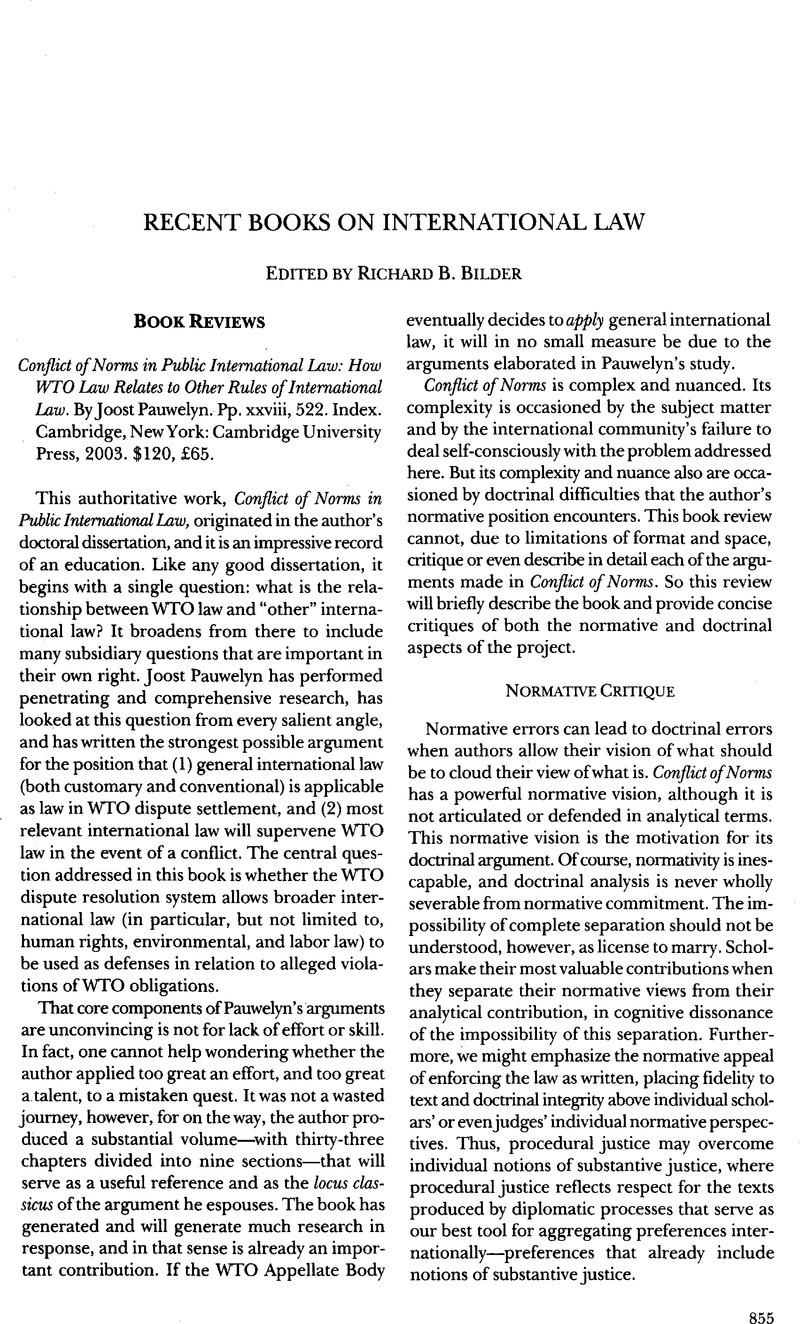Article contents
Conflict of Norms in Public International Law: How WTO Law Relates to Other Rules of International Law. By Joost Pauwelyn. Pp. xxviii, 522. Index. Cambridge, New York: Cambridge University Press, 2003. $120, £65.
Published online by Cambridge University Press: 27 February 2017
Abstract

- Type
- Book Reviews and Notes
- Information
- Copyright
- Copyright © American Society of International Law 2004
References
1 This proposition is articulated in a somewhat different, and more precise, way in Articles 41 and 58 of the Vienna Convention the Law of Treaties, opened for signature May 23, 1969, 1155 Unts 331 Google Scholar.
2 Understanding on Rules and Procedures Governing the Settlement of Disputes, Apr. 15, 1994, Marrakesh Agreement Establishing the World Trade Organization, Annex 2 [hereinafter DSU], in world trade organization, The legal texts: the results of the Uruguay Round of multilateral trade negotiations 354(1999)Google Scholar [hereinafter The Legal Texts]. The WTO legal texts and dispute settlement reports are available online at <http://www.wto.org> .
3 See supra note 1.
4 Oil Platforms (Iran v. U.S.), paras. 39–41 (Int’l Ct. Justice Nov. 6, 2003), 42 ILM 1334 (2003)Google ScholarPubMed. The Courtstated that it could not accept the United States’ position that Article XX, paragraph 1(d), of the 1955 [U.S.–Iran]Treaty was intended to operate wholly independently of the relevant rules of International Law on the use of force, so as to be capable of being successfully invoked, even in the limited context of a claim for breach of the Treaty, in relation to an unlawful use offorce. The application of the relevant rules of international law relating to this question thus forms an integral part of the task of interpretation entrusted to the Court by Article XXI, paragraph 2, of the 1955Treaty.Id., para. 41 (emphasis added). The implication is that the Court had no jurisdiction to apply other relevant rules of international law but could take those rules into account in arriving at an interpretation of Article XX of the 1955Treaty.
5 See, e.g., DSU, supra note 2, Arts. 3, 7, 11; The Jurisdiction of the WTO, 98 ASIL PROC. 135, 139–42 (2004)Google Scholar(remarks of Joel Trachtman).
6 United Nations Convention on the Law of the Sea, opened for signature Dec. 10, 1982, 1833 Unts 397 (1994)Google Scholar.
7 Appellate Body, European Communities—Measures Concerning Meat and Meat Products (Hormones), WTO Doc. WT/DS26 & 48/AB/RB/R (Jan. 16, 1998) (adopted Feb. 13, 1998).
8 Appellate Body, European Communities—Measures
Affecting the Importation of Certain Poultry Products,
WTO Doc. WT/DS69/AB/R (July 13, 1998) (adopted July 23, 1998).
9 Marrakesh Agreement Establishing the World Trade Organization, in The Legal Texts, supra note 2, at 3.
10 Conflict of Norms mischaracterizes Article 41 (b) of the Vienna Convention as prohibiting only inter se modifications that are explicitly prohibited by the earlier treaty (seep. 302). Article 41(b) does not, however, require the prohibition to be explicit.
11 GATT Panel Report, Japan—Trade in Semi–conductors, May 4,1988, GATT B.I.S.D. (35th Supp.) at 116 (1989)Google Scholar.12 In his work on WTO remedies, Pauwelyn contradicts the position that he expresses in Conflict of Norms. There, he argues that WTO obligations cannot be the subject of compensation but must, instead, meet full compliance even where the victim could be fully compensated. He states that “with the advent of the WTO[,] . . . it may be time to move away from the idea of the Gatt/WTO only as a package of bilateral balances between governments.” Pauwelyn, Joost, Enforcement and Countermeasures in the WTO: Rules Are Rules—Toward a More Collective Approach, 94 AJIL335, 341 (2000)Google Scholar.
- 7
- Cited by




